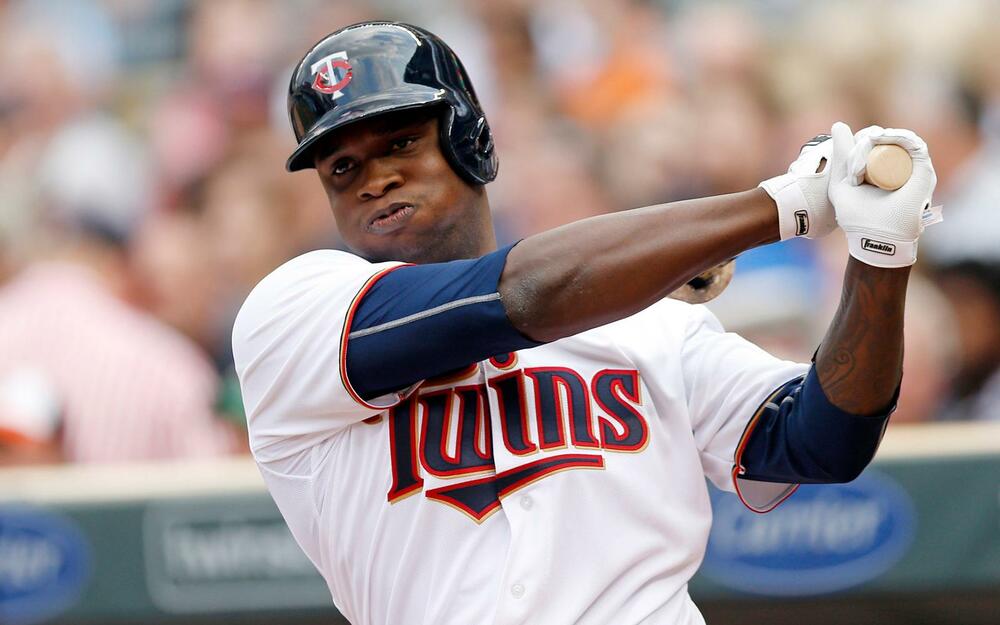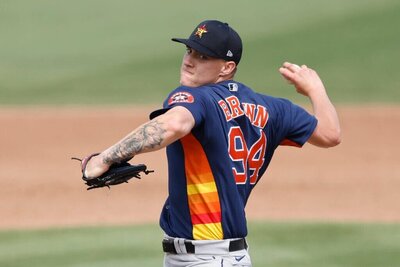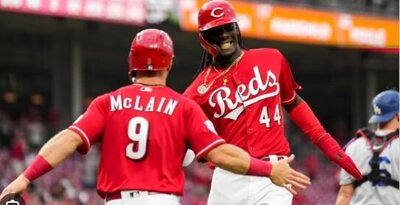Miguel Sanó
Sanó homered twice in three at-bats against the White Sox on Friday. If there's one number that captures Sanó's performance this season it's his .306 ISO; the 26-year-old rarely makes contact, but when he does, the ball flies. Right now, Sanó looks a lot like (and actually a little better in many ways) 2017's Joey Gallo, who slashed .209/.333/.537 -- except that Sanó's career is trending in the wrong direction strikeout-wise. Sanó's plate discipline profile actually isn't that bad -- he owns a 32.3% o-swing rate and 75.1% z-swing rate -- but he just can't make consistent contact and has posted a 62.5% contact rate and 18.6% swinging strike rate. As a result, Sanó has struck out at a ridiculous 42.1% strikeout rate that isn't much higher than his plate discipline and contact profiles indicate (Sanó also really struggles in two-strike counts). Fortunately for Sanó and his fantasy owners, Sanó doesn't need to make much contact to be productive. Sanó owns a 91.6 MPH average exit velocity, 52.5% hard hit rate, and 6.8% soft contact rate, allowing him to post a solid .807 OPS despite a batting average that hovers around the Mendoza line. Don't expect Sanó's strikeout rate to fall below about 38%, but his OPS shouldn't fall below around .780 either.
Yonny Chirinos
Chirinos allowed four runs (three earned) over six innings against the Rangers on Friday. Chirinos has been effective for the Rays this year and took a 3.00 ERA into Friday's game, but his 4.33 FIP is more likely to represent his performance over the rest of the season. Chirinos has been lucky in a number of respects this year, most notably concerning his BABIP (.228) and strand rate (83.1%). xStats don't care much for Chirinos as his xwOBA is 50 points higher than his wOBA and his xBA is similarly split, and those differences are likely driven by Chirinos' .228 BABIP that has persisted despite his mediocre 87.4 MPH average exit velocity, 26% line drive rate, and 9.3% barrel rate. Chirinos' strand rate is also likely to drive his decline over the rest of the season as his 83.1% rate is unsupported by his 21.1% strikeout rate and benefits from a likely unsustainable 19% double play rate (further likely to decline considering his 0.76 GB/FB ratio). That being said, Chirinos may see his strikeout rate rise slightly as his 10.3% swinging strike rate and 79% contact rate suggest a potentially closer to average strikeout rate. Still, Chirinos is likely to take a substantial step back over the rest of the year, and sell high if you can.
Austin Meadows
Meadows went 0-3 with a walk and a strikeout against the Rangers on Friday. Meadows has seen his hot start to the season disappear after returning from the IL in May, and his performance has really fallen over the last few weeks. Two overarching trends have driven Meadows' decline: a rising strikeout rate and a falling BABIP. Starting with the climbing strikeout rate, Meadows has been chasing bad pitches more frequently while making contact on those pitches substantially less frequently (Meadows' z-contact rate is down as well, but far less significantly). This is odd because pitchers have been throwing more fastballs to Meadows over the past month, and his whiff rate is up for all types of pitches. It's possible that Meadows is dealing with some kind of injury -- Meadows fouled a ball off of his foot on June 10th, directly coinciding with his performance decline. That theory might hold some weight considering that Meadows' hard hit rate also began declining around the same time (driving down his BABIP), but it's difficult to tell if that's the root of his problems; Meadows hasn't homered since May 28th, and some decline in his performance was expected regardless of an injury. Still, a foot injury would help explain Meadows' recent struggles and indicates that his performance should improve as he approaches full health.
Daniel Norris
Norris allowed two runs on five hits and one walk over five innings against the Nationals on Friday. There isn't very much to like about Norris for fantasy owners, but his changeup has been filthy this year and has a fairly strong track record of success. For the year, Norris has posted a near 40% whiffs/swing rate with the pitch (ten points over the major league average) to go along with a 40% chase rate, an 87.5 MPH average exit velocity, and a 70% ground ball rate. Those numbers should excite potential fantasy owners, and although they're better then Norris' typical changeup numbers, they aren't completely out of line with its past performance. The real problem surrounding Norris' changeup is its usage; despite its success, Norris uses the pitch less than 15% of the time and largely cut off his slider usage to accommodate for an increase in changeup usage this year. Norris' slider is actually also a usable pitch, but he relies on his poor fastball instead of his slider or changeup. Norris uses his four-seamer about 45% of the time, but the pitch barely touches 90 MPH on average and hasn't posted a slugging percentage below .560 since 2016 (when it sat at .430). If Norris develops a third usable pitch on top of his slider and changeup (he's started bringing his sinker back this year with limited success) or moves to the bullpen (and in both cases ditches his fastball for a more effective pitch mix), then he has a chance to become valuable. Until then, leave him on waivers.
J.P. Crawford
Crawford singled twice in five at-bats against the Astros on Friday. Crawford has played well since being called up by the Mariners in early May, but the 24-year-old appears bound for some negative regression. Let's start with the good: Crawford has maintained solid plate discipline and contact profiles (23.5% o-swing rate, sub-10% swinging strike rate, and 78.2% contact rate) while hitting the ball to all fields (32.5% pull rate, 30% oppo rate) and keeping the ball in the air in the best ways (0.43 GB/FB ratio, 40% line drive rate 11% IF/FB ratio). No matter how well he hits the ball though, Crawford almost certainly won't be able to maintain his .423 BABIP for much longer, especially considering that he still doesn't hit the ball particularly hard (85.9 MPH average exit velocity, 29.5% statcast hard hit rate). Despite his likely inevitable regression, Crawford has shown that he should be a productive fantasy asset through the rest of the season, and there's little to suggest that his likely to decline BABIP will completely derail his season. Don't expect Crawford to maintain all of his early season success (BABIP aside) through the rest of the year (players rarely do), but he will likely continue playing well over the rest of the season.
This is just a small sample our daily analysis, join our member area for over 80 daily player updates sent to your inbox every morning and track your team online. Click here for details: https://www.insiderbaseball.com/baseballsample.htm Click here to register: http://www.fantistics.com/salesbaseball.php3



































